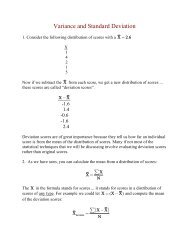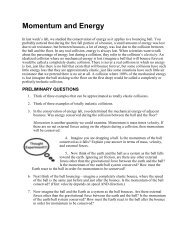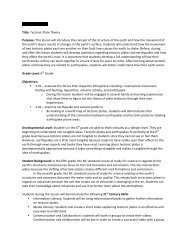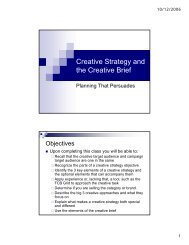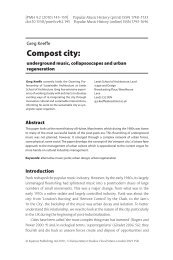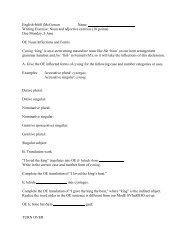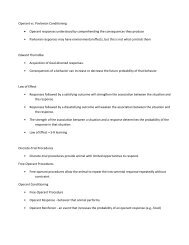Exam 3 - Answer Key
Exam 3 - Answer Key
Exam 3 - Answer Key
- No tags were found...
Create successful ePaper yourself
Turn your PDF publications into a flip-book with our unique Google optimized e-Paper software.
19. The net ionic equation for the dissolution of zinc metal in aqueous hydrobromic acid is __________.A) 2Zn (s) + 2H + (aq) ? 2Zn 2+ (aq) + H 2 (g)B) Zn (s) + 2Br - (aq) ? ZnBr 2 (aq)C) Zn (s) + 2HBr (aq) ? ZnBr 2 (s) + 2H + (aq)D) Zn (s) + 2HBr (aq) ? ZnBr 2 (aq) + 2H + (aq)E) Zn (s) + 2H + (aq) ? Zn 2+ (aq) + H 2 (g)The overall equation is:Zn (s) + 2HBr (aq) ? ZnBr 2 (aq) + H 2 (g)The ionic equation is:Zn+ 2H + + 2Br - ? Zn 2+ + 2Br - + H 2Removing the spectator ion (Br - ) leaves the net ionic eq.:Zn (s) + 2H + (aq) ? Zn 2+ (aq) + H 2 (g)20. Oxidation cannot occur without __________.A) waterB) acidC) airD) reductionE) oxygenIf one species gains electrons, another must be giving up (an equal numberof) electrons21. Which of the following is an oxidation-reduction reaction?A) H 2 CO3 (aq) + Ca(NO 3 ) 2 (aq) ? 2HNO 3 (aq) + CaCO 3 (s)B) Ba(C 2 H 3 O 2 ) 2 (aq) + Na 2 SO 4 (aq) ? BaSO 4 (s) + 2NaC 2 H 3 O 2 (aq)C) HCl (aq) + NaOH (aq) ? H 2 O (l) + NaCl (aq)D) AgNO 3 (aq) + HCl (aq) ? AgCl (s) + HNO 3 (aq)E) Cu (s) + 2AgNO 3 (aq) ? 2Ag (s) + Cu(NO 3 ) 2 (aq)Cu 0 ? Cu 2+ (oxidation)Ag + ? Ag 0 (reduction)In all other cases there is nochange in ox. no. Note that ionson reactant side reappear on theproduct side as well.22. Which one of the following is a correct expression for molarity?A) mol solute/kg solventB) mol solute/L solventC) mol solute/mL solventD) mol solute/L solutionE) mol solution/L solute23. How many grams of NaOH (MW = 40.0) are there in 500.0 mL of a 0.175 M NaOH solution?A) 114B) 3.50 x 10 3C) 14.01 L 0.175 mol. NaOH 40.0 g NaOHD) 3.50500 mL x x x = 3.50 g NaOHE) 2.19 x 10 -3 1000 mL 1 L 1 mol. NaOH24. There are __________ mol of bromide ions in 0.500 L of a 0.300 M solution of AlBr 3 .A) 0.150B) 0.0500C) 0.500D) 0.450E) 0.167Note that each mol. AlBr 3 gives 3 mol. Br - : AlBr 3 ? Al 3+ + 3Br -0.300 mol. AlBr 3 mol. Br1 L 1 mol. AlBr-3-0.500 L x x = 0.450 mol. Br3



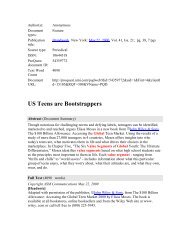

![Graduate Bulletin [PDF] - MFC home page - Appalachian State ...](https://img.yumpu.com/50706615/1/190x245/graduate-bulletin-pdf-mfc-home-page-appalachian-state-.jpg?quality=85)
